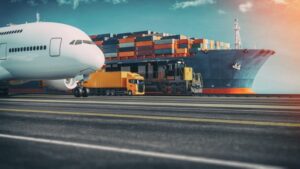Freight shipping is the process of transporting goods by sea, air, or land. It is an essential part of global trade, as it allows businesses to access new markets, expand their customer base, and reduce their costs. Freight shipping also enables consumers to enjoy a variety of products from different countries and regions.
China is one of the largest trading partners of the USA, accounting for about 16% of the total US imports in 2020. Many US businesses rely on freight shipping from China to the USA to source their raw materials, components, finished goods, and inventory. However, freight shipping from China to the USA is not a simple task. It involves a complex and lengthy process that requires careful planning, preparation, and execution.
In this article, we will explain the process of freight shipping from China to the USA, and provide some tips and best practices to help you make the most of it. We will cover the following topics:
- Choosing the right freight shipping method
- Calculating shipping costs and fees
- Customs clearance and documentation requirements
- Tracking and managing your freight shipment
- Dealing with customs delays and potential issues
- Tips for successful freight shipping from China to the USA
Choosing the right freight shipping method

The first step in freight shipping from China to the USA is to choose the right shipping method for your goods. There are three main options: sea freight, air freight, and rail freight. Each option has its own advantages and disadvantages, depending on factors such as the type, volume, weight, value, and urgency of your goods, as well as the distance, cost, and reliability of the shipping route.
Sea freight is the most common and economical option for freight shipping from China to the USA. It is suitable for large, heavy, bulky, or low-value goods that are not time-sensitive. Sea freight can take anywhere from 15 to 40 days, depending on the port of origin and destination, the shipping line, and the weather conditions. Sea freight also has the lowest environmental impact, as it emits less carbon dioxide than air or rail freight.
Air freight is the fastest and most reliable option for freight shipping from China to the USA. It is ideal for small, light, high-value, or perishable goods that need to be delivered quickly and safely. Air freight can take as little as 3 to 5 days, depending on the availability of flights, the airport of origin and destination, and the customs clearance process. Air freight also has the highest security standards, as it is subject to strict screening and inspection procedures.
Rail freight is a relatively new and emerging option for freight shipping from China to the USA. It is a hybrid of sea and air freight, offering a balance of speed, cost, and reliability. Rail freight is suitable for medium-sized, non-fragile, or non-perishable goods that are not too urgent or too cheap. Rail freight can take around 15 to 20 days, depending on the rail network, the border crossings, and the customs clearance process. Rail freight also has a lower environmental impact than air freight, as it consumes less fuel and emits less greenhouse gases.
Calculating shipping costs and fees

The second step in freight shipping from China to the USA is to calculate the shipping costs and fees for your goods. There are many factors that affect the shipping costs and fees, such as the shipping method, the weight and volume of the goods, the distance and route of the shipment, the season and demand of the market, the fuel surcharge, the exchange rate, and the insurance coverage.
The shipping costs and fees can be divided into two categories: the freight rate and the surcharges. The freight rate is the basic charge for transporting your goods from one point to another. It is usually quoted in US dollars per kilogram (for air freight) or per cubic meter (for sea and rail freight). The freight rate can vary depending on the shipping method, the carrier, the origin and destination, and the market conditions.
The surcharges are the additional charges that are added to the freight rate to cover the extra costs and risks involved in the shipping process. Some of the common surcharges are:
- Bunker adjustment factor (BAF): a surcharge that reflects the fluctuation of the fuel price for sea freight.
- Currency adjustment factor (CAF): a surcharge that reflects the fluctuation of the exchange rate for sea and rail freight.
- Peak season surcharge (PSS): a surcharge that applies during the high-demand periods for sea and air freight, such as the Chinese New Year, the Golden Week, and the Christmas season.
- Security surcharge (SC): a surcharge that covers the cost of security measures for air freight, such as screening, scanning, and inspection.
- War risk surcharge (WRS): a surcharge that covers the cost of insurance and protection for shipments that pass through high-risk areas, such as the Middle East, the Gulf of Aden, and the Indian Ocean.
- Terminal handling charge (THC): a surcharge that covers the cost of loading and unloading the goods at the port of origin and destination for sea and rail freight.
- Documentation fee (DOC): a surcharge that covers the cost of preparing and processing the shipping documents, such as the bill of lading, the commercial invoice, and the packing list.
- Customs clearance fee (CCF): a surcharge that covers the cost of clearing the goods through the customs authorities at the port of origin and destination for sea, air, and rail freight.
To get an accurate estimate of the shipping costs and fees, you should contact your freight forwarder or shipping agent, who can provide you with a detailed quotation based on your specific shipment details. You should also compare different quotes from different providers to find the best option for your budget and needs.
Customs clearance and documentation requirements

The third step in freight shipping from China to the USA is to prepare and submit the required customs clearance and documentation for your goods. Customs clearance is the process of declaring and verifying the goods that enter or exit a country, in order to ensure compliance with the laws and regulations of the importing and exporting countries. Customs clearance is mandatory for all international shipments, and it can affect the speed, cost, and success of your freight shipping.
The documentation required for customs clearance depends on the type, value, and origin of your goods, as well as the customs rules and policies of the importing and exporting countries. However, some of the common documents that are required for freight shipping from China to the USA are:
- Bill of lading (BOL): a document that serves as a contract of carriage and a receipt of goods between the shipper and the carrier. It contains information such as the name and address of the shipper and the consignee, the description and quantity of the goods, the port of origin and destination, the freight rate and charges, and the terms and conditions of the shipment.
- Commercial invoice (CI): a document that serves as a proof of sale and a request for payment between the seller and the buyer. It contains information such as the name and address of the seller and the buyer, the description and value of the goods, the currency and method of payment, the incoterms, and the origin and destination of the goods.
- Packing list (PL): a document that serves as a detailed inventory of the goods that are packed and shipped. It contains information such as the number and type of packages, the weight and volume of each package, the description and quantity of the goods, and the marks and numbers of the packages.
- Certificate of origin (CO): a document that serves as a proof of the origin of the goods that are shipped. It contains information such as the name and address of the exporter and the importer, the description and value of the goods, the country of origin, and the signature and stamp of the issuing authority. A certificate of origin is required for some goods that are subject to preferential tariffs or trade agreements, such as the US-China Phase One Trade Agreement.
- Other documents: depending on the nature and category of your goods, you may need to provide other documents for customs clearance, such as a license, a permit, a certificate, or a declaration. For example, if you are shipping food, plants, animals, or other regulated products, you may need to provide a health certificate, a phytosanitary certificate, a veterinary certificate, or a prior notice. If you are shipping hazardous materials, you may need to provide a safety data sheet, a dangerous goods declaration, or a hazardous waste manifest.
To ensure a smooth and hassle-free customs clearance, you should prepare and submit the required documents in advance, and make sure that they are accurate, complete, and consistent. You should also consult your freight forwarder or shipping agent, who can help you with the customs clearance process and advise you on the best practices and procedures.
Tracking and managing your freight shipment

The fourth step in freight shipping from China to the USA is to track and manage your freight shipment throughout the shipping process. Tracking and managing your freight shipment is important for several reasons, such as:
- Monitoring the status and location of your goods
- Ensuring the safety and security of your goods
- Detecting and resolving any issues or delays
- Communicating and coordinating with the relevant parties
- Evaluating and improving the shipping performance
There are different ways to track and manage your freight shipment, depending on the shipping method, the carrier, and the service provider. Some of the common ways are:
- Online tracking: most carriers and service providers offer online tracking tools or platforms that allow you to track your freight shipment by entering the tracking number, the bill of lading number, or the container number. You can access the online tracking tools or platforms through the carrier’s or service provider’s website, app, or email.
- Phone tracking: some carriers and service providers offer phone tracking services that allow you to track your freight shipment by calling a toll-free number and providing the tracking number.
Dealing with Customs Delays and Potential Issues
Another crucial aspect of freight shipping is to deal with customs delays and potential issues that may affect your shipment. Customs clearance is the process of verifying and approving the import or export of goods, which involves checking the documents, inspecting the cargo, and collecting the duties and taxes. Customs clearance can be a lengthy and complicated process, especially for shipments from China to the USA, which have to comply with the regulations and requirements of both countries. Customs delays and potential issues can occur for various reasons, such as:
- Missing, incomplete, or incorrect documents: Documents are essential for customs clearance, as they provide the information and proof of the origin, value, quantity, quality, and classification of the goods. If any of the documents are missing, incomplete, or incorrect, customs may hold or reject your shipment, or impose fines or penalties. Therefore, you should make sure that you have all the required documents, such as the invoice, packing list, certificate of origin, BOL or AWB, and any other specific documents for your product category, such as health certificates, licenses, or permits. You should also make sure that the documents are consistent, accurate, and complete, and that they match the actual cargo.
- Restricted or prohibited items: Some items are restricted or prohibited from being imported or exported, either by the Chinese or the US government, or by the carrier. These items may include dangerous goods, such as explosives, flammable liquids, or radioactive materials, or sensitive goods, such as animals, plants, food, drugs, or weapons. If you ship any of these items, you may face legal consequences, such as confiscation, seizure, or prosecution. Therefore, you should check the list of restricted or prohibited items for both countries and the carrier, and avoid shipping any of them. If you have to ship any of these items, you should obtain the necessary authorization and follow the proper procedures and guidelines.
- Random inspections: Customs may conduct random inspections on your shipment, either by scanning, x-raying, or opening the cargo, to verify the contents and ensure compliance. Random inspections are unpredictable and unavoidable, and they may cause delays or damage to your shipment. Therefore, you should prepare for the possibility of random inspections, and pack your cargo securely and properly, with clear labels and markings. You should also cooperate with customs and provide any additional information or documents they may request.
Tips for Successful Freight Shipping from China to the USA

To ensure a successful freight shipping from China to the USA, you should follow these tips:
- Plan ahead: Freight shipping can be a lengthy and complex process, so you should plan ahead and allow enough time for the shipment to arrive. You should also consider the factors that may affect the transit time, such as the shipping mode, the shipping route, the peak season, the weather conditions, and the customs clearance. You should also have a backup plan in case of any unforeseen circumstances or emergencies.
- Choose a reliable freight forwarder: A freight forwarder can make or break your freight shipping experience, so you should choose a reliable and reputable one. You should look for a freight forwarder that has experience and expertise in shipping from China to the USA, that has a network of partners and agents in both countries, that offers competitive rates and services, and that has good customer reviews and feedback. You should also communicate clearly and frequently with your freight forwarder, and establish a trustful and long-term relationship.
- Optimize your packaging and labeling: Packaging and labeling are important for protecting your cargo and facilitating the identification and handling of your shipment. You should optimize your packaging and labeling by using durable and suitable materials, by minimizing the weight and volume of your cargo, by following the standards and regulations of both countries and the carrier, and by providing clear and accurate information and instructions on your labels. You should also avoid overpacking or underpacking your cargo, as this may cause damage or loss of your goods.
- Insure your shipment: Freight shipping involves many risks and uncertainties, such as theft, damage, loss, or delay of your cargo. Therefore, you should insure your shipment to protect yourself from any financial losses or liabilities. You should choose an insurance policy that covers the full value of your goods, that includes the transportation and storage costs, and that has a reasonable deductible and claim process. You should also read the terms and conditions of your insurance policy carefully, and understand what is covered and what is not. You should also keep a copy of your insurance policy and the proof of delivery, and report any incidents or damages to your insurance company as soon as possible.





